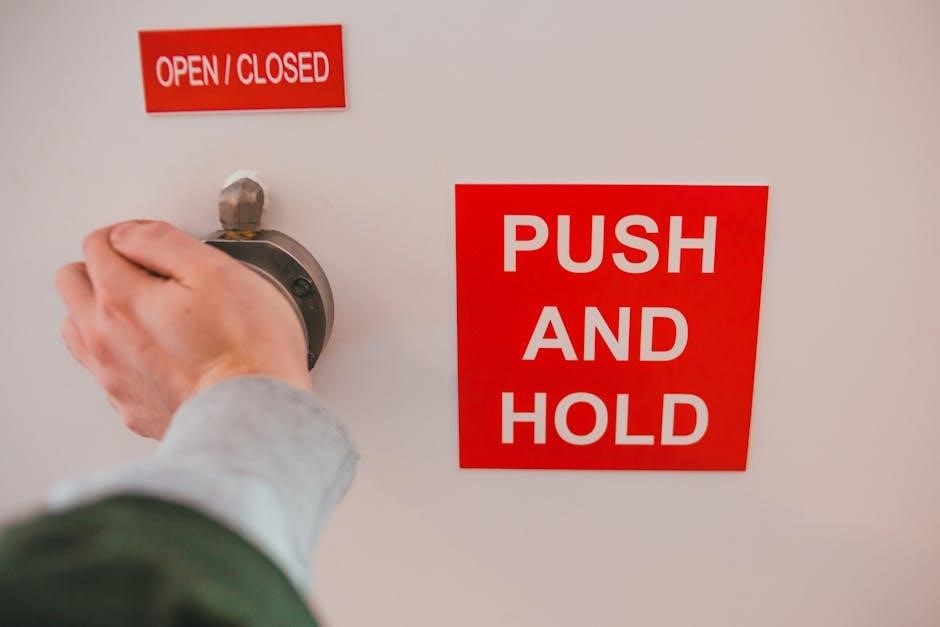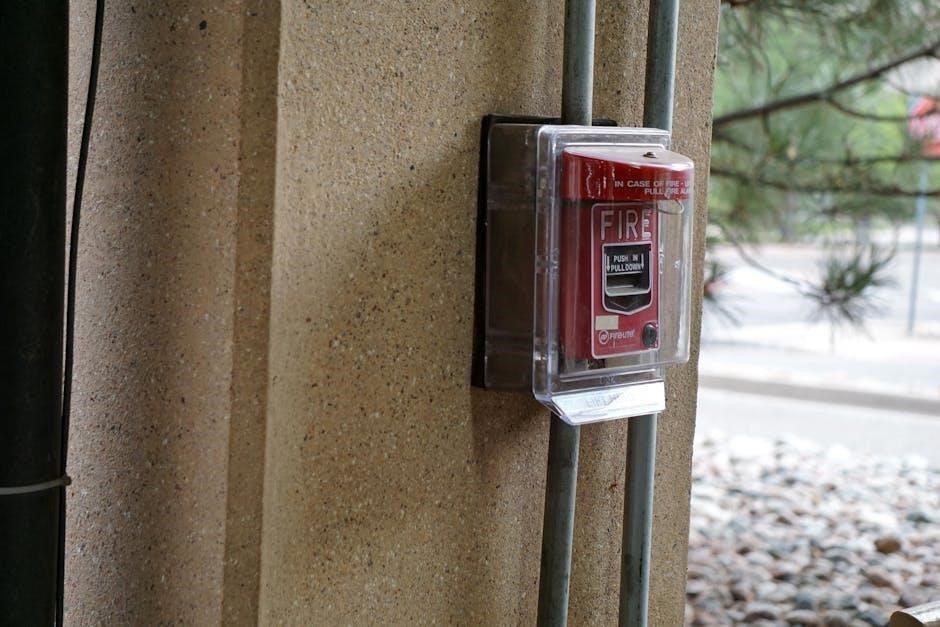The First Alert 9120B is an AC-powered ionization smoke alarm with battery backup, silence, and latching features. It meets UL and ULC standards for residential use.
1.1 Overview of the Device
The First Alert 9120B is an AC-powered ionization smoke alarm with a battery backup, designed for reliable fire detection. It features a silence button to mute false alarms and a latching feature to remember past incidents. The device meets UL and ULC standards, ensuring compliance with safety regulations. It does not include features for hearing-impaired individuals, requiring separate strobe light alarms. The 9120B is part of the BRK Brands product line, offering a user-friendly design with clear installation and maintenance guidelines outlined in its manual. Its compact design integrates seamlessly into residential settings.
1.2 Importance of Reading the Manual
Reading the First Alert 9120B manual is crucial for proper installation, testing, and maintenance. It provides detailed instructions to ensure the device functions correctly, maximizing fire safety. The manual addresses common questions and offers troubleshooting tips to resolve issues like false alarms. By following the guidelines, users can prevent errors and ensure compliance with local fire codes. The manual also highlights the device’s limitations, such as its inability to alert hearing-impaired individuals, prompting the need for additional alerting devices. Proper adherence ensures optimal performance and safety, making the manual an essential resource for all users.

Installation of the First Alert 9120B
The First Alert 9120B manual provides essential installation instructions, ensuring proper setup and functionality of the AC-powered smoke alarm with battery backup for enhanced home safety.
2.1 Pre-Installation Requirements
Before installing the First Alert 9120B, ensure you have reviewed the manual thoroughly. Verify that the device is compatible with your home’s electrical system and existing smoke alarm network. Ensure a 120V AC power supply is available, and gather necessary tools like a screwdriver. Check local fire codes for specific installation requirements. It is also important to note that this unit does not alert hearing-impaired residents; additional devices with flashing strobe lights may be needed. Proper preparation ensures a safe and effective installation.
2.2 Step-by-Step Installation Guide
Begin by mounting the bracket on the ceiling or wall, ensuring it is level. Attach the smoke alarm to the bracket and secure it firmly. Connect the wires to the appropriate terminals, following the manual’s wiring diagram. Install the backup battery to ensure operation during power outages. Finally, test the alarm by pressing the test button to verify proper functionality. Refer to the manual for detailed diagrams and specific instructions to ensure a safe and correct installation.
2.3 Choosing the Right Location
For optimal performance, install the First Alert 9120B on every level of your home and inside each sleeping area. Place alarms at least 10 feet away from cooking appliances to minimize false alarms. Avoid installing near windows, doors, or ducts where drafts may interfere with smoke detection. Mount alarms on the ceiling or high on walls, as smoke rises. Ensure the location is central and unobstructed to maximize coverage. Refer to local fire codes for specific requirements, and always follow the manufacturer’s guidelines for placement.
2.4 Electrical Considerations
Ensure the First Alert 9120B is connected to a 120V AC electrical circuit with a dedicated neutral and ground wire. Install on a circuit that isn’t shared with high-power appliances to avoid interference. Use the provided wiring harness and follow local electrical codes. The alarm includes a battery backup, so replace the battery annually or when the low-battery warning sounds. Avoid using rechargeable batteries for the backup. If installing multiple alarms, interconnect them to ensure simultaneous alerting in case of fire. Always test the alarm after installation to verify proper function.

Testing the First Alert 9120B
Test the First Alert 9120B monthly by pressing the test button to ensure the alarm sounds loudly. This confirms proper functionality and readiness.
3.1 How to Test the Smoke Alarm
To test the First Alert 9120B, press and hold the test button located on the front of the unit. This will trigger the alarm sound, confirming it is working. Ensure the alarm emits a loud, clear signal. If the sound is weak or absent, check the battery or for dust buildup. Test the alarm monthly to verify proper functionality. This process ensures the device is ready to detect smoke and alert occupants in case of a fire. Regular testing is crucial for maintaining fire safety in your home. Always follow the manual’s instructions for accurate results.
3.2 Understanding the Test Results
After testing, verify the alarm sounds loudly and the LED lights flash. A strong, clear alarm indicates proper function. If the sound is faint or absent, check for weak batteries, dust buildup, or electrical issues. Ensure no obstructions block the sensor. If the alarm fails to respond, refer to the troubleshooting section or replace the unit if necessary. A successful test confirms the device is operational and ready to detect smoke. Record the test date and results for maintenance records. Always ensure the alarm is in good working condition to guarantee reliable fire detection. Regular testing ensures safety and compliance with fire codes.
3.3 Using the Silence Feature
The Silence Feature on the First Alert 9120B allows you to temporarily quiet the alarm during false alarms, such as those triggered by cooking smoke or steam. To activate it, press and hold the Test/Silence button until the alarm stops. The LED will flash differently, and periodic beeps may occur, indicating the alarm is in Silence Mode. This feature is temporary and automatically resets after a period, ensuring the alarm remains functional. Use this feature only for false alarms, not in emergencies. If the alarm does not reactivate or if issues persist, check for weak batteries or malfunctions. Remember, silencing should not replace regular maintenance or addressing recurring false alarms.

Maintenance and Upkeep
Regular maintenance ensures optimal performance. Clean the alarm monthly using a vacuum cleaner to remove dust. Replace the battery annually or when the low-battery warning sounds.
4.1 Cleaning the Smoke Alarm
Regular cleaning is essential to ensure the First Alert 9120B functions properly. Use a soft brush or vacuum cleaner to gently remove dust and debris from the cover and sensor. Avoid using water, chemicals, or abrasive materials, as they may damage the unit. Clean the alarm monthly or whenever a “nuisance alarm” occurs due to dust. Proper maintenance prevents false alarms and ensures optimal sensitivity. Always follow the manufacturer’s guidelines to avoid voiding the warranty or compromising the device’s performance.
4.2 Replacing the Battery
To replace the battery in your First Alert 9120B, first turn off the power supply if it is hardwired. Remove the smoke alarm from the mounting bracket and open the battery compartment. Take out the old battery and dispose of it properly. Insert a new 9-volt battery, ensuring it is securely connected. Close the compartment and reinstall the alarm. Test the device to confirm it is working. Replace the battery annually or when the low-battery chirp sounds. Always use a high-quality battery to maintain reliability.
4.3 Regular Maintenance Schedule
Regular maintenance is essential to ensure the First Alert 9120B operates effectively. Clean the alarm monthly using a vacuum cleaner or soft brush to remove dust and debris. Test the alarm weekly by pressing the test button. Inspect the device every six months for any damage or wear. Replace the battery annually or when the low-battery warning sounds. Ensure all connections are secure and functioning properly. Follow this schedule to maintain reliability and ensure your safety. Regular checks help prevent false alarms and ensure optimal performance.

Troubleshooting Common Issues
Address issues like false alarms, chirping sounds, or non-responsive sensors. Clean dust from sensors, replace batteries, or check wiring connections. Resolve problems promptly for optimal safety.
5.1 Common Problems and Solutions
Common issues with the First Alert 9120B include false alarms, chirping sounds, and sensor malfunctions. For false alarms, clean the sensor with a vacuum or damp cloth to remove dust. Chirping indicates a low battery; replace it promptly. If the sensor isn’t responding, check for obstructions or wiring issues. Ensure the alarm is installed correctly and away from cooking areas to minimize false triggers. Addressing these issues quickly ensures reliable performance and home safety.
5.2 Resolving False Alarms
False alarms on the First Alert 9120B often occur due to cooking fumes, steam, or dust. To resolve this, ensure the alarm is at least 10 feet away from cooking appliances. Clean the sensor with a vacuum or damp cloth to remove debris. If false alarms persist, use the silence feature temporarily by pressing the test button. Relocate the alarm if necessary, and test it afterward to confirm proper functionality.
5.3 Addressing Error Conditions
The First Alert 9120B may display error conditions through red LED flashes or chirps. A steady red light indicates normal operation, while rapid flashing signals a problem. Common issues include low battery (one chirp), sensor malfunction (two chirps), or system errors (three chirps). To resolve, replace the battery, clean the sensor, or reset the alarm by disconnecting power for 30 seconds. If errors persist, check for obstructions or damage. For unresolved issues, contact First Alert customer support for further assistance or potential unit replacement.

Key Features of the First Alert 9120B
The First Alert 9120B features ionization technology for detecting fires, a battery backup system, and a latching feature to remember alarm conditions. It meets UL and ULC standards for reliable fire safety.
6.1 Ionization Technology
The First Alert 9120B utilizes ionization technology, which is highly effective at detecting fast-flaming fires. This technology works by ionizing air molecules inside the chamber, creating a small electrical current. When smoke enters, it disrupts the current, triggering the alarm. This method is particularly sensitive to smaller smoke particles produced by flaming fires. The ionization sensor is designed for reliability and quick response, making it a trusted choice for home fire safety. Its advanced microprocessor ensures accurate detection, reducing false alarms while maintaining optimal performance.
6.2 Battery Backup System
The First Alert 9120B includes a reliable battery backup system, ensuring the smoke alarm remains operational during power outages. It utilizes a 9V battery that provides extended runtime and automatically switches to battery power when the main supply is lost. This feature guarantees continuous protection, which is essential for home safety. The system also includes a low-battery warning, alerting users when replacement is needed. This ensures uninterrupted protection and peace of mind for residents.
6.3 Latching Features
The First Alert 9120B features a latching system that provides visual and audible indicators of alarm conditions. The alarm’s LED lights remain on after detection, signaling the source of the alert. This feature helps identify which unit triggered the alarm in multi-unit installations. Additionally, the latching capability ensures the alarm remains in “alarm mode” until reset, preventing false clears. This functionality enhances user awareness and simplifies troubleshooting, ensuring safety and convenience for homeowners. The latching system is a key feature designed to improve response time and accuracy in emergency situations.

Compliance and Regulations
The First Alert 9120B complies with national fire safety standards and is certified by organizations like UL and ULC, ensuring reliability and adherence to regulations.
7.1 Meeting Local Fire Codes
The First Alert 9120B is designed to meet local fire codes, ensuring compliance with safety regulations in various jurisdictions. It features ionization technology, a battery backup system, and latching capabilities, which align with fire safety standards. Users should verify their area’s specific fire codes to ensure proper installation and functionality. The device’s design and certifications help it meet or exceed many local requirements, providing reliable protection for homes and businesses. Always check local fire codes before installation to ensure compliance and optimal performance of the smoke alarm.
7.2 UL and ULC Certifications
The First Alert 9120B smoke alarm is certified by Underwriters Laboratories (UL) and Underwriters Laboratories of Canada (ULC), ensuring it meets rigorous safety and performance standards in both the U.S. and Canada. These certifications confirm the device’s reliability in detecting smoke and alerting occupants. The UL and ULC marks are trusted indicators of compliance with national safety regulations, providing users with confidence in the product’s quality and effectiveness. Always verify the presence of these certifications when selecting a smoke alarm for your home or business, as they are essential for ensuring safety and reliability.
7.4 NFPA Standards
The First Alert 9120B smoke alarm is designed to meet NFPA (National Fire Protection Association) standards for smoke detector installation and performance. NFPA 72, which governs fire alarm systems, outlines requirements for smoke alarm sensitivity, placement, and maintenance. The 9120B adheres to these standards, ensuring reliable fire detection and notification. Compliance with NFPA guidelines helps ensure the device operates effectively in various environments, providing a critical layer of fire safety for homes and businesses. Regular testing and maintenance, as outlined in NFPA standards, are essential to maintain its performance and reliability over time.

Accessories and Compatible Products
The First Alert 9120B is compatible with various accessories, including mounting brackets and interconnect modules, to enhance its functionality and integrate with other safety devices seamlessly.
8.1 Optional Accessories
The First Alert 9120B can be enhanced with optional accessories like the FasTechTM Interconnect Module for seamless integration with other smoke alarms. A remote control is also available, allowing users to test or silence the alarm from a distance. Additionally, compatible carbon monoxide detectors and smart home adapters can be paired with this model to create a comprehensive safety system. These accessories are designed to maximize functionality and ensure your home is equipped with advanced safety features. Always check compatibility before purchasing any additional devices.
8.2 Compatible Smoke Alarm Systems
The First Alert 9120B is compatible with other smoke alarms in the BRK and First Alert interconnected series, such as the 9120B, 710, and 11100 models. These systems allow for seamless integration, enabling all alarms to sound when one detects smoke. The 9120B can connect with up to 18 compatible devices, ensuring whole-home protection. Interconnection enhances safety by providing centralized alerts. Always verify compatibility before connecting multiple devices to ensure proper functionality. This feature is ideal for multi-story homes or large spaces requiring comprehensive smoke detection coverage.

User Responsibilities
Users must ensure proper installation, regular testing, and maintenance to guarantee the smoke alarm functions correctly and provides reliable protection in case of emergencies.
9.1 Ensuring Proper Functionality
To ensure the First Alert 9120B operates effectively, users must perform regular tests, check LED indicators for status updates, and listen for audible alerts. Dust and debris should be vacuumed from the alarm to prevent false triggers. The device should be installed on flat surfaces away from vents to avoid interference. Users are also responsible for monitoring battery levels and replacing them as needed. Proper functionality relies on adhering to the manufacturer’s guidelines and addressing any issues promptly to maintain reliable fire detection and alert systems in the home. Regular checks ensure safety and compliance.
9.2 Replacement Guidelines
The First Alert 9120B smoke alarm should be replaced every 10 years from the date of manufacture, as indicated on the label. If the unit shows signs of wear, such as physical damage or reduced sensitivity, it should be replaced immediately. When replacing, ensure the new alarm is installed according to the manual and local regulations. Dispose of the old unit responsibly, following environmental guidelines. Replacement is crucial for maintaining reliable fire detection and ensuring continued safety in your home. Always use a compatible model to guarantee proper functionality and compliance with safety standards.

Additional Resources
For further assistance, visit the First Alert official website for detailed manuals, FAQs, and troubleshooting guides. Additional resources include instructional videos and downloadable support materials.
10.1 First Alert Customer Support
First Alert offers comprehensive customer support to assist with the 9120B smoke alarm. Users can contact their dedicated support team via phone or email for troubleshooting and installation guidance. Additionally, the First Alert website provides a wealth of resources, including FAQs, user manuals, and downloadable guides. For immediate help, live chat is available during business hours. Their support team is trained to address technical issues, ensuring your smoke alarm operates effectively. Utilize these resources to resolve concerns promptly and maintain your device’s reliability.
10.2 Online Tutorials and Guides
First Alert offers a variety of online tutorials and guides to help users understand and maintain the 9120B smoke alarm. Their official website provides step-by-step installation videos, troubleshooting tips, and detailed maintenance instructions. Additionally, downloadable PDF guides and quick-start manuals are available for easy reference. These resources are designed to ensure users can install, test, and maintain their smoke alarms correctly. By leveraging these tools, homeowners can maximize the safety and reliability of their First Alert 9120B smoke alarm, ensuring optimal performance and peace of mind.
The First Alert 9120B smoke alarm is a vital home safety device. Adhering to the manual ensures optimal performance and protection. Stay informed, stay safe, and proactive about fire safety.
11.1 Final Thoughts
The First Alert 9120B smoke alarm is a reliable and efficient safety device designed to protect homes and families. By following the manual, users can ensure proper installation, maintenance, and functionality. Its advanced features, such as ionization technology and battery backup, provide consistent protection. Regular testing and upkeep are crucial for optimal performance. Remember, a well-maintained smoke alarm is a key layer of defense against fire hazards. Stay vigilant, and trust the 9120B to alert you in critical moments. Your safety is worth the investment in time and attention to detail.
11.2 Encouragement to Follow Guidelines
Adhering to the guidelines outlined in the First Alert 9120B manual is essential for ensuring your safety and the device’s effectiveness. Proper installation, regular testing, and timely maintenance are critical to preventing false alarms and guaranteeing reliable performance. By following these steps, you can trust the alarm to function correctly in emergency situations. Stay proactive in understanding and implementing the recommendations provided. Your attention to detail and commitment to safety will significantly enhance your home’s protection. Remember, a well-maintained smoke alarm is your first line of defense against potential threats.

Leave a Reply
You must be logged in to post a comment.